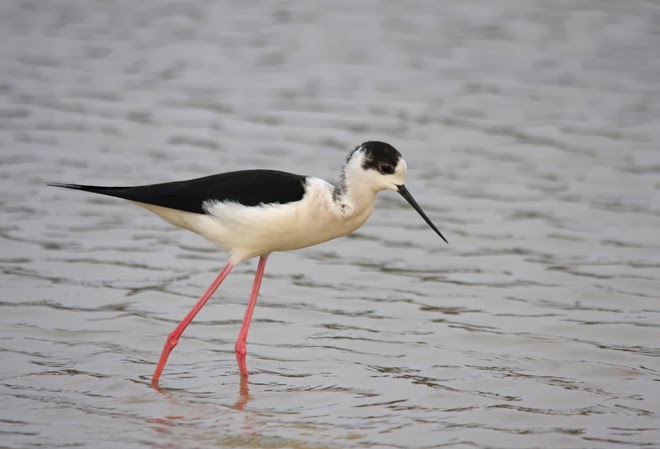Arguably, the best sites in the Osaka area are reclamation areas. Unfortunately access is a problem and the one that we could enter (Sundays only) no longer has the habitat to attract birds. This leaves Nanko Bird Sanctuary in Osaka and Koshienhama in Amagasaki (Hyogo). Both of these areas can be very good. With a car Mie is the place to try, it has a number of good estuaries, tidal flats and with luck flooded fields.
Mie is the only location to find Oystercatchers in Kansai, wintering birds can be found from Tsu city southwards along beaches or on estuaries to neighbouring Matsusaka city a few kilometres away. They arrive in August and are still present in May, so for a winter visitor they're around a long time. They may need a bit of driving round to find.
1 April, 2008.
10 April 2014.
Black-winged Stilt is a fairly common passage bird, usually found on ponds or paddy fields. They are quite widespread inland as well as at coastal sites. Finding them at Ogura depends on whether there are suitable fields at the right time, unfortunately fields usually aren't flooded in spring until after birds have moved through (unlike in Mie) so Nanko Bird Sanctuary in Osaka or the Tsu/Matsusaka area in Mie are best.
Male on Yonaguni, April 2013.
White-headed male with juvenile Mie, September 2013.
Female Yonaguni, April 2013.
Juvenile Mie, September 2013.
Pied Avocet is fairly a rare winter visitor to Japan and I've specialised in just missing them, two or three in Mie, another in Shimane and also in Kyushu. They can turn up anywhere but apparently always somewhere I'm not.
Northern Lapwing is another winter visitor but fortunately for me a reasonably common one, fortunately because this is probably my favourite wader. What a great looking bird. Groups can be found throughout Kansai on arable land whether expansive as in Shiga or more limited areas such as Ogura.
The Mandarin Duck of waders, what a stunner.
Birds near Lake Biwa, it would be unusual not to find at least a few in a day birding in suitable habitat.
For many birders visiting Kansai, Grey-headed Lapwing will be a greater priority and this is one of very few species which are far easier to see here than elsewhere in Japan. They are a common breeder on paddyfields and occur in some tiny scraps even in urban areas. They're almost impossible to miss even from the train and I often see non-breeding gatherings on factory roofs or car parks. It doesn't get much stranger than seeing birds in pachinko parlour car parks.
Along the Katsura River in the Kyoto suburbs.
Moulting adults and first winter birds can look very plain though not often as drab as this. December 2012, near the Uji River, Kyoto.
The striking wing pattern normally so eye-catching becomes interestingly inconspicuous in winter. This bird near northern Lake Biwa.
Pacific Golden Plover can turn up anywhere on wet or dry fields on passage, it isn't uncommon but you often need luck to connect with them. This is even more true in winter as there are very few birds remaining this far north.
Newly arrived spring migrants on Mishima (Yamaguchi), May 2010.
Breeding plumage at dawn.
Post-breeding August 2014, Mie.
Grey Plovers are coastal and are fairly easy to find in Mie and it can also often be found at Nanko Bird Sanctuary in Osaka. No doubt they will be equally easy to find in suitable habitat on the Japan Sea coast but the Mie area is more convenient to cover from a Kyoto/Osaka base.
Different degrees of moult August 2011, Mie.




















No comments:
Post a Comment